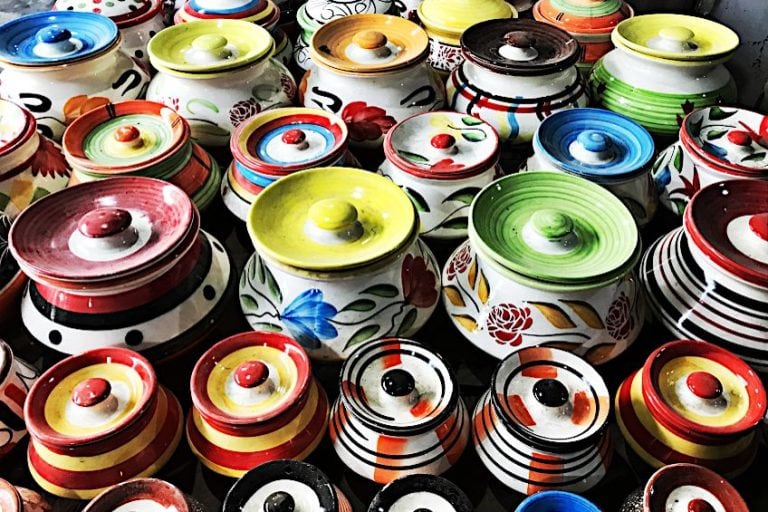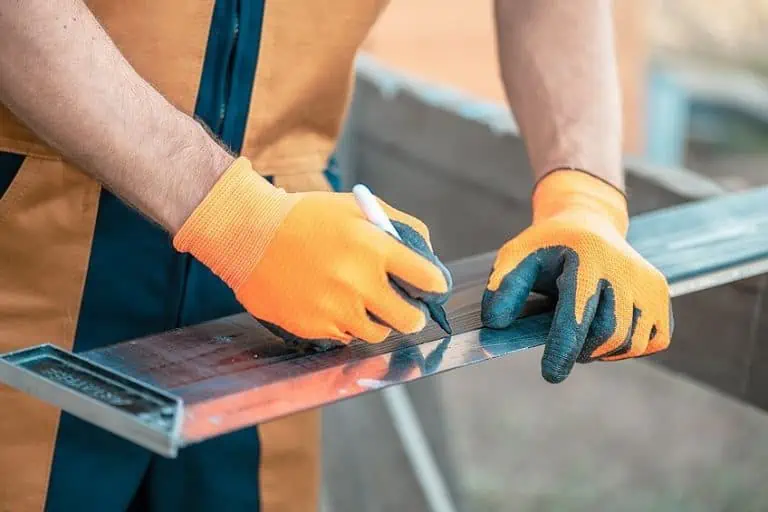What Are Standard Canvas Sizes? – Ultimate Canvas Sizes Chart
This post may contain affiliate links. We may earn a small commission from purchases made through them, at no additional cost to you.
Many like to display photographs of their family, while others want to display their new painting projects. To do this you first need to choose the right frame for your photographs or choose the right canvas for your next painting, and for this project to be perfect, the size of the frame or the canvas size must be correct. So, before you go out and start shopping for that new canvas, you need to take time to consider what are the typical canvas sizes available. We will be helping you with this very important decision so that you choose the right canvas dimensions and avoid any disappointments.
Table of Contents
What are Typical Canvas Sizes?
Finding the right size canvas for your art piece can become challenging because you do not want to buy a canvas that is too small, or too big, it must be the right size, as just a few inches can make a big difference. This discrepancy can cause an imbalance between your art piece and the wall, and the place where you want to hang it does not look or feel right.
If you are a seasoned artist, then this is not a big issue as you have been buying canvases for a long time. However, what about the beginner? The only way that you can be sure the canvas you buy is the right one, is to learn about canvas dimensions and to understand that all the common art canvas sizes are similar to the picture frame sizes. We will now be discussing these canvas dimensions, which should prove to be a handy reference in choosing the right size of canvas for your oil or acrylic painting.
What are standard canvas sizes? There are more than fifty different canvas sizes available, and learning what standard canvases sizes entail, will help you choose the correct canvas. Many artists choose to work on the more common rectangular-shaped canvases, which are usually medium in size. These types of canvases are also ideal for the beginner to practice on, as they are not too big, or too small. Below we will be dealing with each canvas size in detail. Please take note that all the dimensions given below are in inches.

Mini Canvas Sizes
Any canvas that measures less than 4 x 6 inches is classed as a mini canvas where most of them are square. This also includes an ACEO (Art Cards Editions and Originals) size, which is slightly bigger than the average business card. These mini-size canvases are ideal for creating those small painting dimensions where you can display a whole row of them on your wall. The mini size canvases include:
- 2 x 2 inches
- 3 x 3 inches
Small Canvas Sizes
Small canvas sizes are used when you are doing miniature paintings, creating bold or single images. They can be used for postcards or greeting cards and can be scanned later or even turned into various forms of stationery designs. These small canvas sizes require remarkable skill and accuracy to produce an artwork this small, but the most common small sizes of canvas include:
- 4 x 6 inches
- 5 x 7 inches
Medium Canvas Sizes
If you are a beginner and you are not sure what size canvas to buy, then the medium size is the best option. This size of the canvas is ideal as it has a larger surface area for you to paint on, and it is not too big to frighten you off painting forever. The canvas is big enough to use a variety of different brushes and explore many different types of painting techniques. This might not be the right size painting to hang in a large room, but you will still be able to create your very own beautiful painting. The most common medium-size canvases include:
- 8 x 10 inches
- 9 x 12 inches
- 11 x 14 inches
- 12 x 16 inches
Large Canvas Sizes
The large canvas sizes are perfect once you gain more experience and increase your skill level. The larger painting dimensions can make an impact in a bigger room or become the centerpiece in your living room. This size of the canvas gives you ample room to create a large work of art, like a sweeping landscape scene. The large canvas sizes are much easier to work on when placed on an easel than on a flat surface. The most common large size canvases include:
- 18 x 24 inches
- 20 x 24 inches
- 24 x 36 inches
- 30 x 40 inches
- 36 x 48 inches
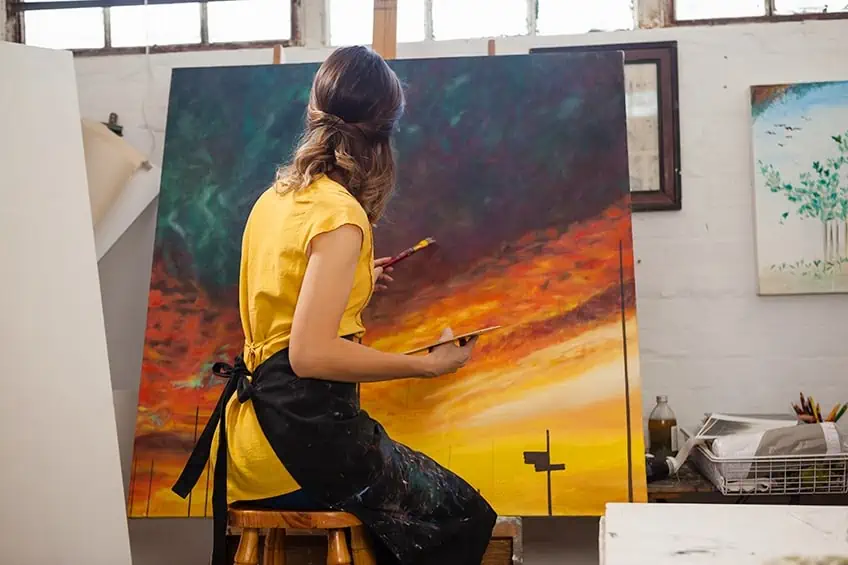
Square Canvas Sizes
Although the square canvas sizes are used less than the rectangular sizes, they are still very popular amongst artists, as you can easily display your square canvas art pieces side by side, producing a perfect balance to your display. They are also available in several different sizes, which include the following:
- The mini sizes, which include the 2 x 2 and the 3 x 3 inches
- 8 x 8 inches
- 10 x 10 inches
- 12 x 12 inches
- 20 x 20 inches
Shaped Canvas Sizes
There are a variety of shaped canvas sizes that are available and include circles as well as ovals that are by far the most popular. You can also find shapes like hearts and hemispheres. A shaped canvas is designed for a special purpose and is rather difficult to frame. The sizes of these shaped canvases vary according to the individual needs, and what is available in stores.
Oblong Canvas Sizes
These canvas sizes are different from the rectangular sizes as they are long in one direction but very short in the other, almost like a panoramic view photograph, and can be placed in both landscape and portrait positions. They are not very common canvas sizes but are still used where the artist wants to place the paintings next to each other or where a tall view or object is painted on the canvas. The sizes of the oblong size canvases may vary, but the most common sizes are:
- 3 x 9 inches
- 12 x 36 inches
Custom-Made Canvas Sizes
If you are looking for a canvas that is larger than the common sizes that are listed above, then you can buy a specially sized canvas. Also, if you have your own canvas, you can stretch it to any size or shape you want. Be aware that the custom-sized canvases are very expensive, especially if they are larger sizes, and when it comes to framing and hanging, it could be a problem.

Standard Canvas Sizes Chart
What are standard canvas sizes? We have just discussed the various sizes, and apart from all of those sizes mentioned above, there are still many more canvas sizes that are available. There are also custom-made canvas sizes that the manufacturers will make for you if your order is large enough and then any size can be made for you. Below is a chart showing a few of the typical canvas sizes in inches that you can purchase without having to have them specially made up. These can be square, oblong, or other shapes of the canvas.
| Small Canvases | Medium Canvases | Large Canvases |
| 5 x 5 | 10 x 8 | 18 x 24 |
| 4 x 6 | 10 x 10 | 20 x 24 |
| 7 x 5 | 12 x 9,10 | 24 x 36 |
| 6 x 6 | 12 x 12 | 30 x 40 |
| 8 x 8 | 14 x 10,11 | 36 x 48 |
| 14 x 14 | ||
| 16 x 12 |
Some Popular Standard Canvas Sizes and Their Uses
You may be planning to create your very own gallery wall in your home or just choosing the right canvas for your next DIY project, remember that the right size of canvas can either make or break your project. So, you must spend some time finding the right size canvas that will fit your project. We have compiled a few of the more popular size canvases for you and where they are best suited for displaying.

10 x 8 Inch Canvas
This is a very popular size for your gallery wall paintings in your home and is also a very versatile size for a wide range of artwork pieces. The canvas can be used for your family photographs or an image you have copied onto your canvas. To give you an idea of its actual size, you can compare it to an ordinary piece of copy paper, which can be used for portrait or landscape art pieces. This canvas size is referred to as a medium-size canvas and can also be used for gifts to give to friends or family. These canvases are ideal for mounting in small hallways or studies.
12 x 12 Inch Canvas
This size of the canvas is meant for slightly larger artwork and is also ideal if you are limited to wall space. You can also use it for single images, or you can break it up and form a photo collage, so the incentive is up to you to use your creativity with photos of various sizes. This is a square canvas size and is ideal for various images, turning them into a custom wall gallery. Since these canvases are square, they are perfect as a centerpiece and can also give you more symmetry when displaying your art pieces. This is a perfect size to use on your wall gallery, living room, and bathroom.
24 x 10 Inch Canvas
This may appear to be a slightly odd size, but it has many possibilities. This oblong canvas size fits perfectly over your mantelpiece, above your headboard in your bedroom, or even over the kitchen stove.
This size canvas is perfect for panoramic views of the city, or countryside, or even for a large family portrait. However, with this size of canvas, you want to ensure you do not lose any quality and must capture the correct dimensions and every fine detail. This size is ideal for use in long hallways, over the fireplace mantels, or in the kitchen.

24 x 36 Inch Canvas
This canvas size is one that you can use to impress your family and friends, and as a large canvas it is ideal in a large room but also must be the only one on that wall if you want to get the full benefit from it in your room. Large canvases can still be used as part of your wall gallery, but it always looks best if it is the centerpiece. Large canvas sizes are ideal for use in bigger living rooms, bedrooms as well as in-office spaces.
What to Consider When Selecting the Right Canvas Size?
During the Renaissance period, painting was done on wooden panels but today oil, as well as acrylic painting, is done on canvas. This is because canvas can be stretched across wooden bars allowing you to create larger paintings that are also portable. The canvas also provides you with a more stable surface where you can experience less cracking and warping, which happens with the wooden panels. You may want to stretch your own canvas or buy a prepared stretched canvas. There are various canvas materials to select and what you want to do will govern the decision on the type of canvas you choose.
Canvas Aspect Ratio
After all of this information, you may still be wondering why it is so important to select the best canvas size. Why not just choose any canvas size to paint on? The reason is that once your painting is finished, it needs to be framed, and frames also come in different sizes. You need to be sure that your finished canvas will fit into your frame without having to crop any off to make it fit. In the good old days of oil painting, the artist would stretch their own canvas, and they could be sure of the right canvas size for the frame. This can still be done today but at a very high price. If you are a beginner in oil painting, we recommend you stick to the typical canvas sizes that will fit into any of the standard size frames.
Another point to take into account is the aspect ratio. All canvases follow the aspect ratio, which means the relationship between the height and the width of the canvass. For example, square canvas sizes have a 1:1 ratio as all sides are the same, and a canvas with a ratio of 1:2 indicates that one side is twice as long as its opposite side, like a 10 x 20-inch canvas. This aspect comes into play when you want to paint from a print, picture, or photograph onto your canvas, and you need to work out the ratio of the print so that you buy a canvas that is the right size.
This is simple when you work with standard ratios like 1:1 or 1:2, but what if you have a print that measures 8 x 10 inches, then the math can become a problem. So, we have included a small chart with all the ratios that will help you when you want to buy your canvas.
| Ratio | Canvas Size (inches) |
| 1:1 | All Squares |
| 1:2 | 10 x 20 or 12 x 24 |
| 2:3 | 20 x 30 or 24 x 36 |
| 3:4 | 9 x 12 or 12 x 16 |
| 4:5 | 8 x 10 or 16 x 20 |
| 5:6 | 20 x 24 |
Canvas Material
There are only two fiber types when it comes to canvas making, and these include cotton and linen. Hemp and jute are also used for canvas making, and even though they are different fibers, they are still considered as extra-linen.
Cotton Canvas
Although cotton is more economical to use, it is not as strong as linen and has also not been tested over time as the linen has. Cotton is also very easy to stretch, and it will stay tight over the stretcher bars, however, linen has longer fibers as it is made from flax and is also much stronger. This means that the linen is less likely to tear on the staple line or over the sharp corners. Also, you can use a thinner linen material, which will give you the same strength as a heavier cotton material. There is also the cotton duck canvas that has a more tightly woven thread than the plain cotton canvas and is fairly thick. The cotton duck canvas is used throughout the world today and is popular, as it is cheaper and can be bought in a roll or per meter.
Many artists make use of the Italian Poly-Cotton canvas, as it has a tight weave, a smoother surface, and finer thread, and you can also buy the no-grain canvas that has a super fine texture. When polyester was added to the canvas make-up, it made the canvas more relaxed than the cotton and will not come loose, even over time.
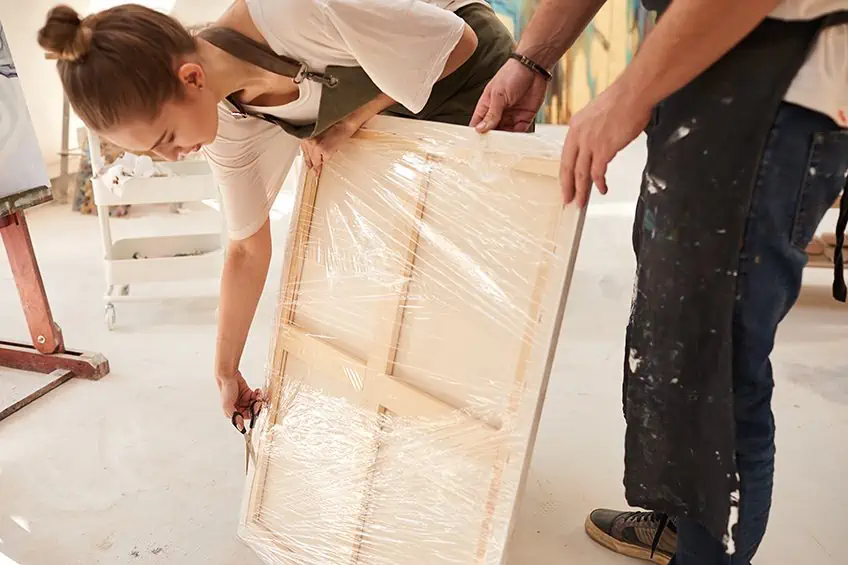
Linen Canvas
The linen canvas is more expensive than the cotton canvas, mainly due to the demand in the marketplace. The cotton canvas is not only used for paintings but has many more non-art uses, making it a lot cheaper to buy. However, there is a cotton canvas specially designed for professional artists, which is of far better quality, making it more expensive than the ordinary cotton canvas. The linen canvas is much smoother and has a tighter spun yarn, making it much stronger than the cotton canvas. The linen canvas has a harder surface finish, which allows it to survive a lot of rough treatment like repainting, scraping, and glazing. Linen canvases are also much easier to stretch than cotton canvases.
Using linen may feel special for some artists to paint on, and to use oil paints that are made from linseed oil as both of these products are made from the flax plant. There is also jute canvas you can use for a 3D texture, and the price is fairly reasonable even though it is very thick.
Canvas Weave
It is not only important for you to consider the type of fiber material, but you also need to consider the texture and weight of the weave. Just as the paper has a weight and a weave, so a canvas is measured in ounces per square yard (oz). So, if the linen has a heavyweight, then it can be thick and tough or tightly woven.
All the lightweight linens are of a fine yarn with an open weave, making them much easier to stretch and tighten, and are normally used by artists that have a light touch or for those who draw. However, impasto painters have also been found using them.
A fine canvas is smooth, and a rough canvas has a more pronounced weave, so you need to decide if you want a canvas that can build up layers of paint or a canvas that has a smooth surface where the weave is not a factor. A smooth textured canvas is used by portrait painters, a rough-textured canvas will distort the appearance of the skin. As far as textures go, there are rough, medium, fine, and extra-fine textured canvases that you can choose for your particular project.
Canvas Weight
If you use a heavier weight canvas, it will be able to take more tension without tearing, which means if you are using large canvas sizes, it is better to use a heavier canvas material. The weight of the canvas means how much of the fabric is contained in an area and takes into account the thickness, the thread as well as the weave. A thick thread gives you a heavy canvas, while a thin thread gives you a lighter canvas. A light-weight canvas is usually around five ounces per square yard, a medium-weight canvas around eight ounces per square yard, and a heavy-weight canvas around 10 ounces per square yard or more, these weights are for unprimed canvases. When it comes to a primed canvas, the weight includes the primer, and some canvases have thicker layers of primer, so it makes it very difficult to determine the exact weight of a primed canvas.
Stretched Canvas vs. Canvas Panels
This choice is up to the individual as some artists prefer to paint on a canvas that has been stretched across bars, while others prefer the canvas to be mounted on a panel. The main difference between these two options is that the stretched canvas gives movement and can stretch, causing the paint to crack, but the panel-mounted canvas is more solid and rigid, giving better support to your canvas.
Many of the art stores and craft stores stock stretched canvases as well as canvas panels, which will be a better idea if you are a beginner. Many artists prefer to stretch their canvas, which is a lengthy and costly exercise and better left to the professionals. For very large paintings, the only way to do it is to use a stretched canvas, as the larger canvas sizes are not readily available in canvas panel options.
Stretched Canvas
This is a process where the canvas is stretched over a wooden frame, known as stretcher bars, and is the most popular option used for acrylic painting. The canvas is normally made from cotton, and if you buy one from the art store, it comes with a gesso primer already applied to its surface. However, you need to be careful as you have primed canvases that are used for oil painting and a different primer used for acrylic painting, so be sure you purchase the correct one. The stretcher frames are supplied in different thicknesses and sizes. The ordinary thickness can be used for paintings that you want to frame, and the deeper frames for paintings that you want to leave unframed, which can be painted on the sides as well. Many artists enjoy the spring that the stretched canvas gives, where you can feel the spring action against your brush.
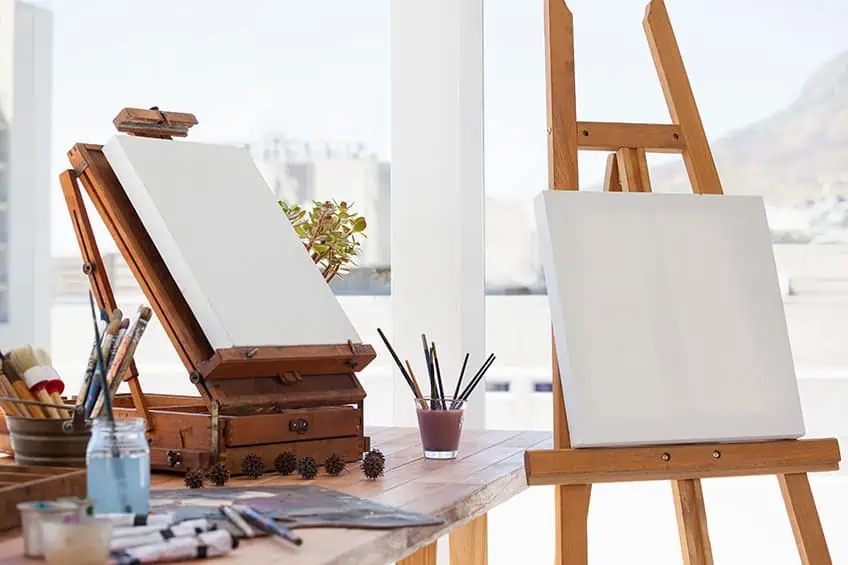
Canvas Panels
Canvas panels are a lot cheaper than stretched canvases, especially if you are just starting, and are of very high quality. They are normally made from primed cotton, which is mounted onto a rigid lightweight board that is either glued down at the back or cut to the size of the board. The canvas is usually much thinner than the stretched canvas, and because it is mounted on a lightweight board, making it portable, and is, therefore, very convenient for students and outdoor painting. The rigid board that is used for mounting the canvas panel is normally made from plywood, heavy board, solid wood, Gatorboard (plastic impregnated foam board), or stiff and thin plasticized card. The main disadvantage with the canvas panel is that if you knock it against something, it may damage the corners causing the paint to crack. Below we have selected a few comparisons between the canvas panel and the stretched canvas.
| Features | Stretched Canvas | Canvas Panels |
| Rigidity | Can loosen or sag over time or due to temperature changes | Remains rigid all the time |
| Mounting | Difficult to mount | Easy to mount |
| Portability | Not east to transport | Easy to transport |
| Durability | Can be easily damaged | Very durable |
| Cropping | More difficult to crop | Easy to crop |
| Storage | Needs larger storage space | Can be stored easily |
Framing
Should you frame your painting or not? Framing is an art on its own and selecting the right frame can bring your painting to life. The different styles and types of frames are endless, but you need to bear in mind that the frame and the painting are viewed together; therefore, they must complement each other. The object is to try and not allow the frame to overpower your painting. Should you take extra care when thinking of framing an oil painting? Watercolor and acrylics dry by water evaporation, but oil paintings dry through oxidation, so even if the painting feels dry to the touch, depending on how many layers of paint have been applied to the canvas, it could take years to dry properly. If the oil painting is framed behind glass, it could trap the moisture behind it, and because the canvas cannot breathe, it may start to rot.
Choosing Your Space
Where you are going to hang your painting is a vital factor to consider when choosing the right canvas size. Take, for example, a small canvas size will not have the impact you want if it is going to hang on a large wall by itself. On the other hand, a large canvas size hanging in a small, cramped corner of the room is also not ideal. The correct place to hang large canvas sizes should be in your lounge, dining room, or where there is enough space.
Artists have often experienced that instead of one large or oblong canvas size, it is better to split the image or picture into a couple of smaller size canvases. This looks great when mounted alongside each other. If the size of the canvas is still a problem, then we suggest that you go along with the most common size of canvas that is bought by many artists and DIY painters. In this regard, the canvas size 36 x 24 inches seems to be very popular.

Budget
Unfortunately, when faced with the decision to buy the right size of canvas, the budget has a major role to play. If your cash flow is tight, you may find yourself cutting some corners which could affect the quality of the canvas size you want to buy. Some of the factors that affect the price are the size of the canvas include:
- The quality of the material
- Whether you want to buy a cotton or linen canvas
- Deciding on a stretched canvas or a canvas panel
- The manufacturer and store you buy the canvas from
Conclusion
It is very important to have a strategy when choosing the right size canvas for your paintings. This means that sticking to the most common or popular size of canvases used, will save you a lot of money as well as a lot of time. The typical canvas sizes can be bought at any art or craft store, which will save you a lot of time as you do not have to stretch and prime the canvas yourself. You will also find that these canvas sizes will fit into any standard size frame that you can buy at most craft or hardware stores.
View our Canvas Sizes web story here.
Frequently Asked Questions
How to Determine an Accurate Canvas Size?
Measure the space you plan to mount the painting on the wall, then multiply those sizes by 0.60 and 0.75. For example, if your space measures 72 inches by 28 inches, then the canvas size you need to buy is 40 x 20 inches.
What is the Best General Canvas Size?
The 30 x 36 inch appears to be the most common and popular size used, and this size can be used as a painting that stands alone or amongst other paintings on your gallery wall.
What is the Largest Canvas Size?
Remember that the large canvas sizes can only be used as stretched canvases and cannot exceed 72 x 36 inches. You should take care when using this size, as it tends to sag and warp a lot easier.
What Size Canvas is the Smallest?
The smallest canvas size that we recommend you use is 5 x 5 inches. However, you can get mini canvases that go from 4 x 6 inches, 2 x 2 inches, and 3 x 3 inches.
In 2005, Charlene completed her wellness degrees in therapeutic aromatherapy and reflexology at the International School of Reflexology and Meridian Therapy. She worked for a company offering corporate wellness programs for several years before opening her own therapy practice. In 2015, she was asked by a digital marketer friend to join her company as a content creator, and it was here that she discovered her enthusiasm for writing. Since entering the world of content creation, she has gained a lot of experience over the years writing about various topics such as beauty, health, wellness, travel, crafting, and much more. Due to various circumstances, she had to give up her therapy practice and now works as a freelance writer. Since she is a very creative person and as a balance to writing likes to be active in various areas of art and crafts, the activity at acrylgiessen.com is perfect for her to contribute their knowledge and experience in various creative topics.
Learn more about Charlene Lewis and about us.

